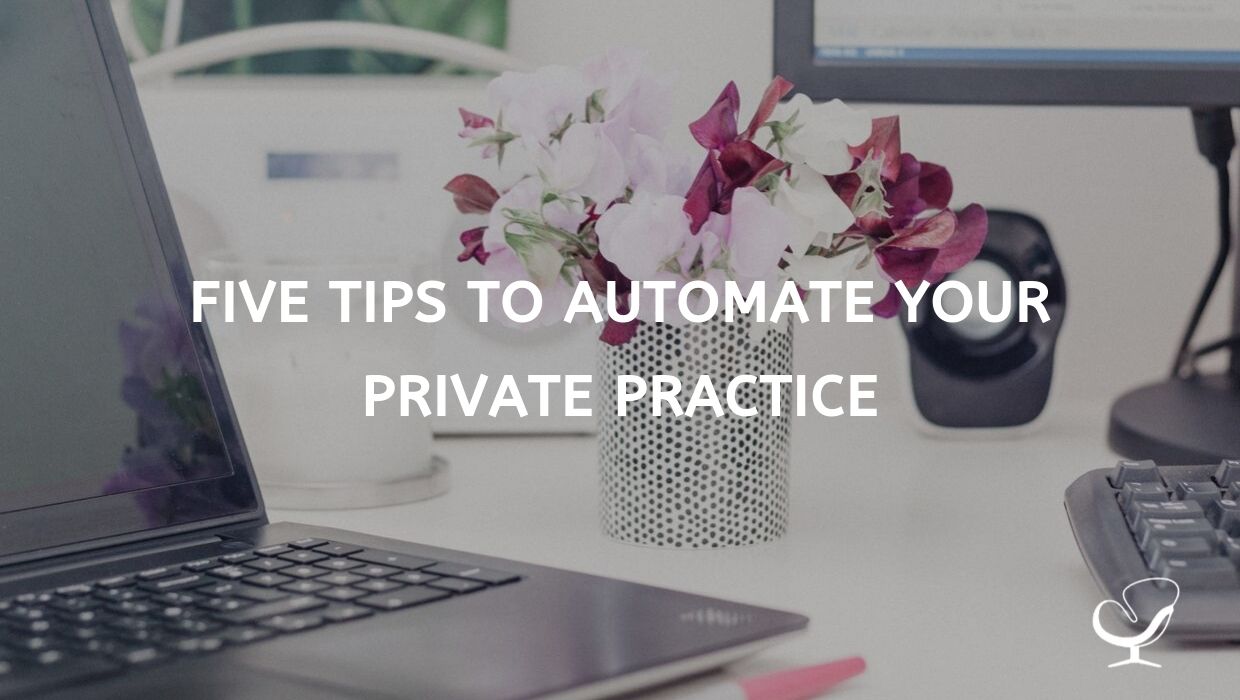My transition to private practice was rough because there is a steep learning curve towards opening your own business. I tried to plan for everything as much as I could, without automating private practice and still wasn’t prepared for all that I encountered. There were some aspects of running a practice that I was unaware of. One example is how to open a business bank account. I had no idea what documentation was needed, which banks offered the best rates, or the process to even get started. I also didn’t know that your business must be licensed in the same state as the bank you’re trying to open an account with.
My point is that I went from having a few responsibilities at the group practice in which I previously worked to having to do everything myself. It’s not as easy as it seems. On top of that, I felt like I spent more time doing administrative work for my practice instead of providing direct services for my clients. So, I think automating private practice is great.
It allows you to streamline different processes within your business without expending any extra energy on your end. This is something I’m sure a lot of therapists don’t fully take advantage of in handling business matters. Below is a list of five areas in your practice that you can automate. *Reminder: Make sure everything you use is HIPAA compliant and provides you with a Business Associate Agreement (BAA).
Intake Paperwork
The initial paperwork can be extensive for a prospective client. However, there are ways to make the process easier for automating private practice. I prefer my clients to complete it online because I’ll receive it instantly and both parties will be able to make a copy of it for their records. Although that’s my preferred option, it’s still very important to have hard copies of your paperwork available for those who would rather not handle this process electronically.
There are multiple options for therapists to have clients complete their paperwork, such as Electronic Medical Record (EMR)/Electronic Health Record (EHR) systems and websites dedicated for people to sign forms. I have my paperwork available for completion in my practice management platform. For whichever method you choose, make sure it is HIPAA compliant and provides you with a BAA. I suggest reading these two articles on private practice paperwork (Starting Your Paperwork Off Right in Private Practice, 16 Things You Must Have in Your Paperwork) if you need assistance.
Scheduling
A time-effective schedule is essential to having an organized private practice. You won’t be able to meet the scheduling needs for all of your clients and give everyone their preferred time. For example, most of my practice consists of seeing children and adolescents which means the afternoon hours are in high demand. Those slots are always going to be full for me, but I do my best to work with clients and help them achieve an optimal appointment timetable.
Automating a schedule is very beneficial and convenient. If something changes or if their preferred time is unavailable, you won’t have to contact clients multiple times to determine alternative meeting times. It lets you put some responsibility on the client to be accountable for scheduling their sessions. There will probably still be some clients that you’ll have to schedule yourself, but scheduling 3-4 clients yourself is easier than doing the same for 30 clients. Depending on your scheduling system, there should be an option to set recurring appointments. This also makes your work easier after initially setting your schedule.
Another component of automating your schedule is having appointment reminders automatically sent to your clients. I suggest having this done within 24-48 hours of the appointment, as this gives clients the opportunity to contact you and cancel if needed. Appointment reminders and confirmations have been proven to greatly reduce the number of no-shows. We owe it to ourselves to streamline this process as much as possible.
Billing
I haven’t done enough billing on my own yet to fully comment on this area. From my experience, it seems that insurance providers will let you submit claims for free on their client portal or other approved platform(s). Some EMR/EHR systems are also able to submit claims on your behalf for a small fee.
Some insurances have a more tedious process than others for submitting claims. You could submit those claims using the free methods, but that time spent may be better allocated for completing other administrative tasks or having additional sessions which leads to more revenue. It could be time and cost effective to have this process occur automatically in your EMR/EHR platform. The money made from one session should be more than enough to pay for all of your submitted claims in a given month.
It is important to research your EMH/EHR system to understand the fee process for submitting claims. It could be a flat fee per month, a charge per claim, or a combination of both. Make sure you are fully informed before you make a decision on this area of your practice.
Phone System
During my years in private practice, I’ve learned that prospective clients like reaching a live person when they contact a business about receiving services. It’s definitely good to reach out in a timely manner if you’re unable to answer any incoming calls. Having a comprehensive phone system is important for those moments you’re unable to answer inquiries. Your practice appears more professional if your phone system matches the quality of larger organizations.
My practice’s phone system has a greeting and presents different extensions to transfer the caller based on their needs. The extensions are also useful because I’ll know the general subject of the voice message when I check it. Currently, my office number is set up to route the calls to my personal cell phone. Those with more revenue and resources should consider hiring an assistant, or even a virtual assistant to field your calls. Click here to learn more about the benefits of hiring virtual assistants.
Social Media
Automating practice private with your social media pages is conditional. It really depends on how often you post or want to post, and the type of content to be shared with your audience. Some items may only need to be posted once. However, if a majority of your information contain evergreen content (posts that can be recycled), then it may be beneficial for you to plan your posts weekly or even monthly to help you save time. There are plenty of different social media management systems available. I suggest you do some research and determine which one is best for the stage of your practice. Other factors to consider are which social media platforms your practice utilizes and who is the intended audience.
Hopefully after reading through these points, you will see how automating tasks can reduce some of the stress and nuances of running a private practice. This is for those who are working alone and have not hired an assistant or receptionist. Time is very important and the time saved on conducting administrative duties can be used for leisure, self-care, or to have more sessions and increase your revenue. Automating some of these processes may cost extra money, but it will pay in areas of convenience and productive time management. As the saying goes “work smarter, not harder”…or at least work smart and hard concurrently. I believe doing that will help you maximize your outcomes.
 Michael Gilliard II was born and raised in Charleston, SC. He a Licensed Professional Counselor (LPC) and Nationally Certified Counselor (NCC) in Georgia. His private practice is named Ujima Counseling, Coaching, and Consulting. It is based on the Kwanzaa principle of Ujima which means “to build and maintain our community together and to make our brother’s and sister’s problems, our problems and to solve them together.” He is also working on experiences which integrate mental health and XR technology. Please contact him to learn more.
Michael Gilliard II was born and raised in Charleston, SC. He a Licensed Professional Counselor (LPC) and Nationally Certified Counselor (NCC) in Georgia. His private practice is named Ujima Counseling, Coaching, and Consulting. It is based on the Kwanzaa principle of Ujima which means “to build and maintain our community together and to make our brother’s and sister’s problems, our problems and to solve them together.” He is also working on experiences which integrate mental health and XR technology. Please contact him to learn more.

